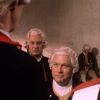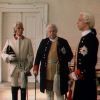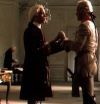In this post, I've collated some of Katte's final words, written and spoken.
In late August, in prison, Katte was interrogated. The first confession that he wrote, often referred to as his "species facti," is behind the cut. The ellipses are in the source I obtained them from. [ETA: Missing material, as well as summaries of other Katte interrogations, can be found
here.]
![[personal profile]](https://www.dreamwidth.org/img/silk/identity/user.png) selenak
selenak, who translated the text from German, writes, "Bear in mind: Katte was threatened by torture if he didn't confess all, and of course he knew the punishment for desertion under FW if this was what it was judged to be and wanted to live, so with that caveat, here's what he said happened:"
( Species Facti 1 )Wilhelmine records a passage Katte wrote on his prison window, before he was condemned to death:
( Prison window )Immediately after receiving his death sentence, on November 2, 1730, Katte wrote to the King asking for a pardon. Translation is from
Waldie's Select Circulating Library.
( Letter to FW )He also wrote to his grandfather, Field Marshal von Wartensleben. Wartensleben also wrote to the King asking for a pardon, but was refused. The following letter is taken from Wilhelmine's memoirs, who likely copied it from a pamphlet that began to circulate immediately after Katte's death. The letters in it, to his father, grandfather, and brother-in-law, appear to be genuine, and were circulating in Berlin already in November 1730.
( Letter to grandfather )The following letter, to Katte's father, written the night of November 5 at Küstrin, only hours before his execution at 7 am on November 6, is taken from Fontane. The translation is cobbled together from Wikipedia, Lavisse, Google translate, and my own limited knowledge of German.
( Letter to father )He also wrote an undated letter to Fritz, urging repentance. The German text is found in Preuss, and the translation in Waldie. It's referred to as the "Puncta" in an August 1731 letter from Wolden to FW.
( Letter to Fritz )There are several variants on Katte's last words to Fritz, as he was led past his window on his way to his execution. All of the exchanges involve Fritz asking for pardon, often wishing he were in Katte's place, and Katte indicating that there's nothing to forgive.
( Katte's last words )We also had some thoughts on these documents. First, Katte's bullet-pointed last letter to Fritz.
( Who actually composed this letter? )Then we did some digging into the question of who leaked those letters to Katte's family so quickly that they were circulating in November 1730, and they were evidently never denied and are treated as genuine. (I haven't been able to find a copy of the brother-in-law letter reported by Wilhelmine.)
First, we got our hands on the anonymous
pamphlet published in 1731 that contains the leaked letters, and found that it contains a two-page summary that reads very much like an eyewitness account, in that it matches the existing eyewitness accounts--Major Schack, Preacher Besser, and Münchow--very closely, as well as FW's orders to Lepel. We therefore concluded that the leaker of the letters was someone at Küstrin.
Then it came to our attention, thanks to Koser, that the 1731 pamphlet is almost verbatim the same as the official report of the Danish envoy to Berlin, von Johnn. He, or someone close to him, is therefore almost certainly the leaker of the letters. Furthermore, the detail in his various reports pertaining to the escape attempt makes it seem like he had access to the state archives in Berlin.
So most likely, von Johnn had someone in his pay at Küstrin who was able to give him an eyewitness account of the execution, and possibly the letter to Katte's father. However, that letter may have been copied and sent to the Berlin archives, as it appears that Katte's other letters (to the King and his grandfather) written in Berlin were. From the archive, the Danish ambassador was able to get copies of the letters as well as official reports.
From him and/or his staff, the letters and the eyewitness account in the official report made their way into an anonymous pamphlet published in 1731.
ETA: Stratemann has a very similar account, recounted
here, which I think may have been relayed to him via Johnn. Both reports were written in Berlin on November 11, and Johnn was no fan of FW and evidently eager to disseminate knowledge of Katte's execution to all and sundry.
( The tyrant demands blood )














































